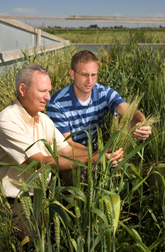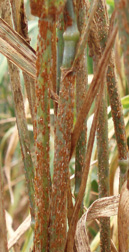This page has been archived and is being provided for reference purposes only. The page is no longer being updated, and therefore, links on the page may be invalid.
| Read the magazine story to find out more. |
 ARS plant pathologist Mike Bonman (left) and ARS molecular biologist Eric Jackson have identified some wheats among the 3,000 wheat landraces in the U.S. National Small Grains Collection that may have resistance to new wheat rust diseases. Click the image for more information about it. |
|
|
Stem Rust-resistant Wheat Landraces Identified
By Sharon DurhamOctober 24, 2011
U.S. Department of Agriculture (USDA) scientists have identified a number of stem rust-resistant wheat varieties and are retesting them to verify their resistance.
Stem rust occurs worldwide wherever wheat is grown. Over a large area, losses from stem rust can be severe, ranging from 50 to 70 percent, and individual fields can be destroyed.
Agricultural Research Service (ARS) plant pathologist Mike Bonman at the agency's Small Grains and Potato Germplasm Research Unit in Aberdeen, Idaho, and his colleagues screened more than 3,000 wheat landraces from the National Small Grains Collection against new races of the stem rust pathogen found in wheat fields in Kenya. Landraces with confirmed resistance are being crossed with susceptible wheat to determine the genetic basis of the resistance.
ARS is USDA's principal intramural scientific research agency, and the research supports the USDA priority of promoting international food security.
Field trials in Kenya to screen for resistance are vital to this work, according to Bonman, who worked at the International Rice Research Institute (IRRI) for 9 years before coming to ARS. He is now working collaboratively with the International Maize and Wheat Improvement Center (CIMMYT) near Mexico City, and the Kenya Agricultural Research Institute (KARI).
Excellent procedures have been developed by CIMMYT and KARI personnel to promote rust disease in the nursery, enabling Bonman to evaluate which ARS accessions are resistant to rust. According to Bonman, CIMMYT facilitates the nursery and site logistics, and ARS helps with evaluating the level of rust development in wheat varieties.
The research team's goal is to find new genes for resistance to a rust strain called Ug99, because that strain has the capacity to overcome many of the resistance genes that have been used for the past 50 years. This work will help Africa's growers now and will help suppress disease and reduce damage in developing countries. It also will prepare the United States for Ug99 if the disease arrives here, according to Bonman.
Read more about this and other cooperative studies between ARS and international research partners in the October 2011 issue of Agricultural Research magazine.

